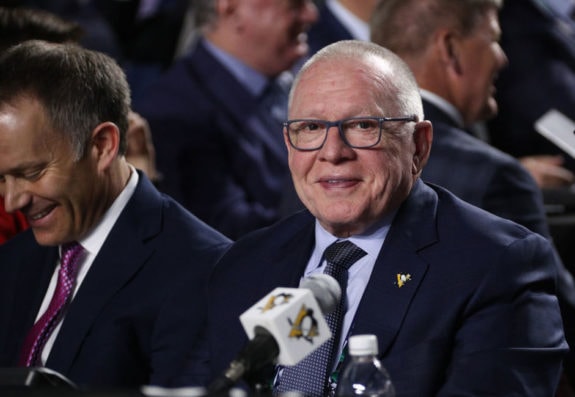Fifteen years is a long time to do anything with consistency, much less make the playoffs in a league where no team is guaranteed to have sustained success. The NHL playoffs, and the road leading up to it, is widely considered the most difficult path to a trophy in all of sports, and the Pittsburgh Penguins are no strangers to it. With three Stanley Cup Championships in this 15-year window, the Penguins have proven themselves to be a team weathered for adversity in the past. Ironically enough, this season has given the Penguins similar tests. Despite the incredible situations and problems they’ve found themselves in this season, they have continued to find a way to win and have success. This article will break down the top moments of adversity that propelled them to their 15th straight playoff appearance.
Departure of Jim Rutherford
Adversity found the Penguins from the very beginning this season, kickstarted with the sudden departure of their long-time general manager Jim Rutherford, reportedly leaving the Penguins due to personal reasons. This immediate shake-up came only seven games into the season (4-2-1 record in that span), providing a cloud of uncertainty for the Penguins and their future. It didn’t take long before David Morehouse and Mario Lemieux got to work to hire Ron Hextall and Brian Burke to fill the void. Hextall, an ironic choice given his long history rivaling the Penguins, joined the team as Rutherford’s replacement at general manager. Burke, however, was hired as a director of hockey operations, essentially as Hextall’s right-hand man.

When hired, Burke and Hextall made it clear they were “taking inventory” of the team and willing to move big pieces of the team should they feel the need. Since their hirings, the Penguins have flourished, going 29-10-2 and putting themselves atop the heavily contested MassMutual East Division. They’ve also managed to increase their power play, which was abysmal to start the season, to 10th in the league under Hextall and Burke (21.8%). The Penguins have thrived under the pressure of an uncertain future and new management, along with the possibility of long-time members being moved should the team not perform to their fans’ and owner’s expectations.
Injury Bug Hits the Defense
The Penguins have had their fair share of injuries this season, starting on the back end. All of their starting six defensemen were injured at one point or another during the first half of the season, including the likes of Kris Letang, Brian Dumoulin, John Marino, Cody Ceci, Mike Matheson, and Marcus Pettersson. The loss of their defensive corps forced unfamiliar faces such as Pierre-Olivier Joseph, Mark Friedman, Yannick Weber, William Reilly, and Kevin Czuczman into the limelight, who held their own and helped keep the Penguins afloat in this trying portion of the season.
With over 250 man-games lost this season, ranking 7th in the NHL in this category, the Penguins’ defense continued to surprise throughout the months of February and March. The most notable story to come of this unfortunate cross-section of injuries is undoubtedly Pierre-Olivier Joseph. POJ shined in the spotlight in his short stint in a starting role with the team, racking up 5 points and a +1 in 16 games played.
He averaged 16:47 per game in this 16 game span, playing as much as 26:14 against the New York Rangers on Feb. 1st. Not only did POJ prove he is a capable depth piece for this season’s playoff run, but also that he can become a quality top-4 defenseman for the Penguins down the road. The team’s defensive depth has been through the wringer this season but has proven themselves to be equal to the task thus far.
Key Offensive Losses
While the Penguins have not experienced many injury-related issues on the defensive end since mid-March (knock on wood), they certainly got their trials on the offensive side of the puck as well. The Pens lost several key players in their top 9, most notably Brandon Tanev, Teddy Bleuger, Kasperi Kapanen, Evgeni Malkin, and Jason Zucker. Most teams, especially given the circumstances regarding a difficult division and tight schedule, would have collapsed with the loss of big-name players like Malkin and Kapanen. Astoundingly, the Penguins bent but never broke.

The Penguins were forced to bring several names into the lineup who otherwise would be members of the taxi squad or their AHL affiliate, the Wilkes-Barre/Scranton Penguins. Players like Frederick Gaudreau (2-3-5 in 15 GP), Anthony Angello (2-2-4 in 19 GP), and Radim Zohorna (2-2-4 in 8 GP) stepped in and immediately made a difference for the Penguins. It also helped that the first line, which has been relatively healthy this season, has been on fire. Sidney Crosby, Jake Guentzel, and Bryan Rust have all combined for 150 points this season.
On top of this, the Penguins are the only team to boast three or more 20+ goal scorers this season, all three being on the top line. The addition of Jeff Carter helped make an immediate impact after being acquired at the trade deadline, putting up four goals and two assists in 10 games played so far. The combination of tremendous play from the remaining regulars on the forward corps along with new faces chipping in at big moments has been key in the Penguins’ race to first in the East.
The Penguins have always seemed to operate well during crunch time. Whether it be their repeatedly strong performances in March every year (thus “March of the Penguins”) or their nine-straight playoff series wins between 2016 and 2018, the Pens find ways to thrive under pressure. This season, as much as any, has proven that they’re not only a perennial playoff team but that they still have the pieces in place to make a push for the Stanley Cup. This season’s team has a very similar composition to that of the 2016 Stanley Cup team, and the fans and team can only hope that they yield the same final result.